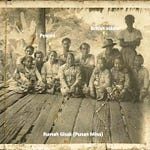According to the anthropologist Prof. Bernard Sellato, several small ethnic groups in central Borneo—namely the Sian, Bhuket (also called Bukit or Ukit), Lugat, and Lisum—originate from a mountainous region that forms a natural divide between the Baleh, Kanowit, Skrang, Saribas, and Batang Lupar river basins.
Sellato’s theory suggests that these groups may have once belonged to the same larger ethnolinguistic stock, perhaps even a single people before historical migrations fragmented them. He links them to an older and now obscure group known as the Sru or Seru, implying that the Sian, Bhuket, Lugat, and Lisum are descendants of this earlier cultural-linguistic entity.
What led to their fragmentation and dispersal? Two major waves of migration reshaped this region’s ethnographic landscape:
The Kayan migration from Apo Kayan into the Baleh River region, where they encountered and resisted existing groups.
The subsequent migration of the Iban (Dayak Iban) from the Batang Kapuas area in the 17th century, which further displaced earlier inhabitants.
Sellato’s view is corroborated by respected Iban scholar Dr. Benedict Sandin, who acknowledged these historical displacements. The Punan, too, were deeply affected by these migrations—both through direct conflict and forced relocation.
Geographical and Ethnographic Overlap
If we examine historical geography, there’s evidence that groups like the Sru and those connected to them (Sian, Lugat, Lisum, Bhuket) once lived near Punan communities during the 17th century. At that time, the Punan Nuo lived between the Gaat River and the mouth of the Baleh, while the Punan Tekalit occupied the Katibas River region (also spelled Ketiva).
Both groups became targets of aggression—not only by the Iban but also by the Memaloh and Bukitan. By the early 18th century, the Punan Nuo and Tekalit were effectively displaced. Some survivors relocated to Kanowit. Among their leaders was a man named Tani, who was later beheaded by Malay authorities in Sarikei around 1959, accused of involvement in an uprising in Kanowit.
Punan Relocation and the Rise of New Identities
As the Iban expanded throughout the Rejang Basin during the 19th century, the Punan gradually became concentrated in the upper regions between Pelagus Rapids and Belaga. Even as late as 1882, a Punan longhouse was still standing on the Selemin (Chermin) River, visited by De Windt, the brother-in-law of Charles Brooke. He remarked that the longhouse resembled those of the Kanowit.
By the late 19th century, while the Punan settled between Pelagus and Belaga, other groups like the Sian, Lugat, and Lisum took up residence near Pelagus Rapids. For further details on this period, Hugh Brooke Low’s 1882 writingsremain invaluable.
Between 1882 and 1924, Iban dominance in the Baleh area intensified. The Bhuket/Ukit, who resisted Iban expansion, fled to Baluy. Some sought refuge among the Kenyah of the Mahakam River, especially the Lepo Tau. Today, the descendants of these refugees—Sian, Lisum, and Lugat—live along the Lunuk River and are now known as Punan Lisum, Punan Sian, and Punan Lugat. Similarly, the Beketan, who also faced Iban pressure, are now referred to as Punan Beketan.
Why Are They Called “Punan”?
This is a critical question. The term “Punan” (and “Penan”) was not originally self-designated. It was a label used by neighbouring communities—like the Kenyah and Kayan—for nomadic groups within their territories. In other regions, such as those dominated by the Ot Danum, similar groups were referred to as “Bukit”, while in Malay-majority areas, they were known as “Basap.”
Over time, these externally given names—exonyms—were adopted by the nomadic groups themselves. Yet, from a cultural and linguistic standpoint, many of them are not ethnically Punan, even though their languages have absorbed Punan influence.
Unfinished Inquiry
This remains an open and under-researched field. As our own discussions have shown, there are shared features and key differences between the Punan and the other so-called “Punan” or nomadic groups. These distinctions are evident in language, social organisation, and material culture, but they are yet to be fully explored.













Share this post